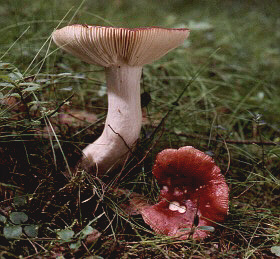- Russulaceae
Taxobox
name = Russulaceae

image_width = 200px
image_caption = "Russula emetica"
regnum = Fungi
divisio =Basidiomycota
classis =Agaricomycetes
ordo =Russulales
familia = RussulaceaeRussulaceae is a family of
fungi in the orderRussulales . Its species have typically friable, chalk-like stalks, that break with a distinct crack, like a carrot but with porous flesh (see below). Microscopically, the cells are not all long thinhypha e, which would provide strength and more fibrous appearance when broken. Instead the flesh contains also many large spherical cells ('sphaerocysts'), which give rise to the macroscopic consistency.Genera
The family is dominated by just two well-known genera:
*The genus "
Russula ", sometimes known as Brittlegills, comprises around 160 species, the majority of which are quite difficult to identify. They have splitting gills and do not exude a milky substance at cut surfaces, contrarily to the genus "Lactarius ". There are several edible species ("Russula vesca ", "Russula virescens " or "Russula aurata ").* The genus "
Lactarius ", or Milk-caps, characterized by caps and stalks that exude a milky substance ("latex ") when pressed or cut and lactiferous,gloeoplerous hypha e, is a large genus ofmycorrhiza l fungi. When cut, the mushroom exudes a kind of milky liquid. This liquid is may be orange, red, lilac, white or yellow, and may develop its final colour only after exposure to air. Certain ones, such as "L. deliciosus" are edible and delicious, very much appreciated in Mediterranean areas.However [http://www.catalogueoflife.org/browse_taxa.php?path=0,5597,5702,5703,5924,5927&selected_taxon=5927 the ITIS Catalogue of life] includes also the genera "Cystangium", "Gymnomyces", "Macowanites" and "Zelleromyces" in this family.
Distinctive flesh consistency
Due to the presence of large spherical cells which can be seen under the microscope, an important characteristic to distinguish the Russulaceae from other types of mushrooms is the consistency of the stipe. In "Russula" and "Lactarius", this breaks like the flesh of an apple, whilst in most other families it only breaks into fibres. The pictures compare the broken stipe of a "
Lactarius vellereus ", with that of "Suillus variegatus ", a member of theBoletaceae .Parasites
Members of both "
Lactarius " and "Russula" are subject to parasitization by theLobster mushroom ("Hypomyces lactifluorum"). Thisascomycete replaces the flesh of the host mushroom, rendering it into a choice edible, though it can be peppery if the host is a species like "Lactarius piperatus ".These fungi may also be parasitized by the
Indian Pipe , amyco-heterotrophic plant that lacks chlorophyll.External links
* [http://www.mushroomexpert.com/russulaceae.html Taxonomy in Transition: The Russulaceae]
References
* The section on "Distinctive flesh consistency" was taken from the German article.
Wikimedia Foundation. 2010.
